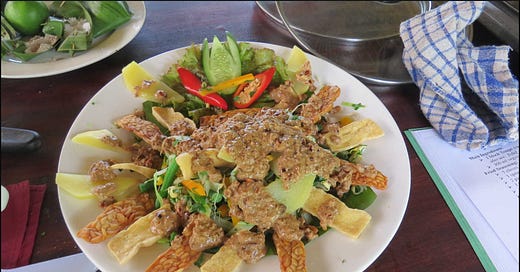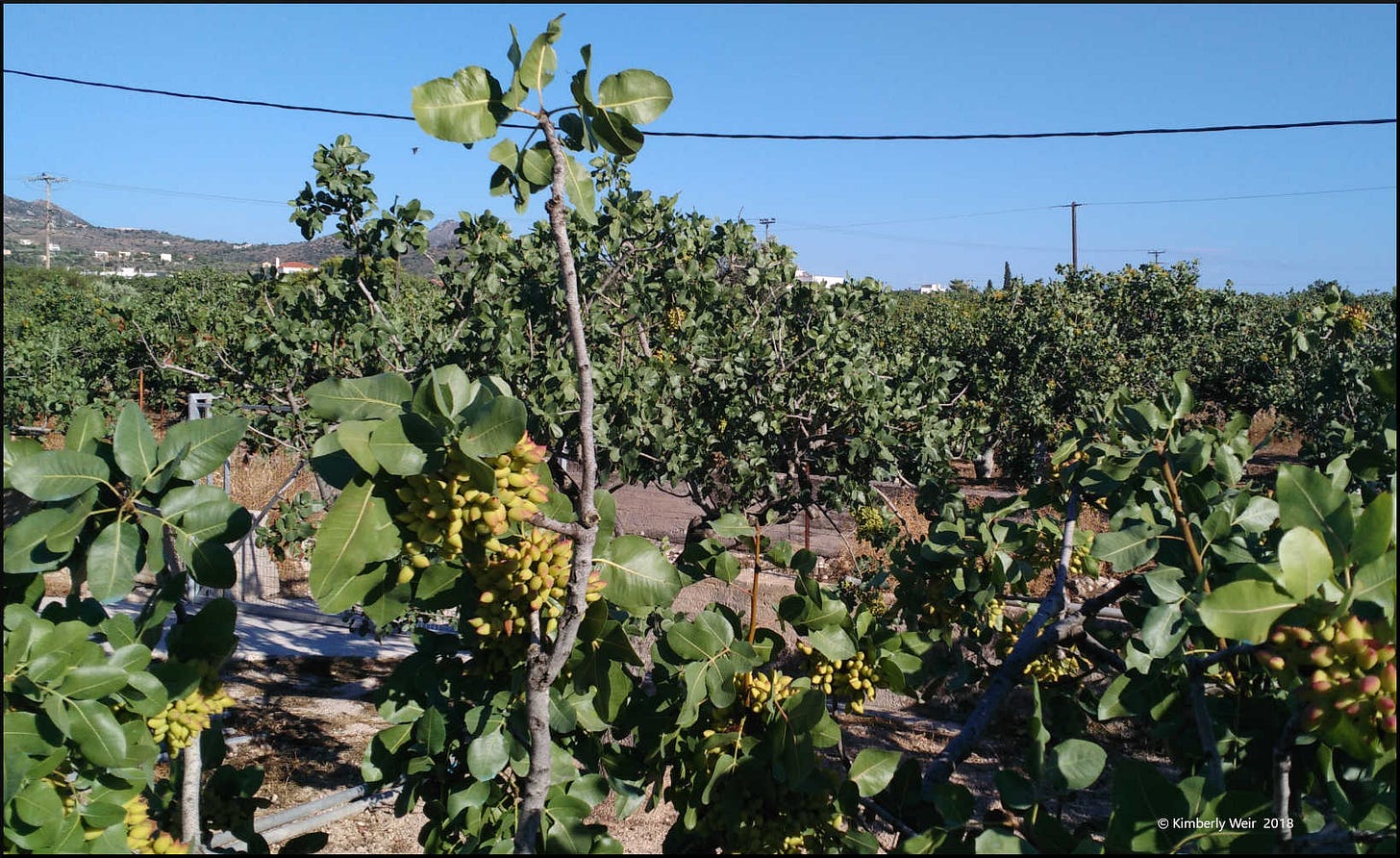The Superstars: Sustainability Superfoods
How nine great-tasting, complete protein plants that helped build empires outperform meat in nutrition and sustainability, proving plant-based eating never means compromise.
In my last post, considering the trade-off of cotton for hemp, I mentioned that both are edible. At the time, I was only familiar with cotton seeds being pressed into oil, but as people who grew up around cotton fields probably know, in fact, the seeds, leaves, and flowers are edible. Few have missed the hype that hemp seed gets as a ‘superfood’. It’s a well-deserved title, as few plants provide all nine essential amino acids, making them complete proteins.
Hemp is in the company of the pseudo grains quinoa, amaranth, and buckwheat, spirulina (an algae), and soybeans. Pepitas (pumpkin seeds), pistachios, and chia seeds are also considered complete proteins, though slightly lower than the others in one essential amino acid, lysine. These superfoods provide the nutritional benefits of animal products, but with the added bonus of being free of saturated fat and cholesterol. Swapping out meat for any of these superfoods means it’s still possible to consume essential nutrients, countering the myth that someone with a plant-based diet cannot get enough protein. Plus, they’re not only better for the body, but they’re also sustainability superstars.
The Ancient Fuel Sources
The ancient pseudo grains are all highly adaptable crops, require a negligible number of inputs (fertilizers, pesticides, etc.), and need little water. Buckwheat sustained the Mongol Empire and amaranth powered the Aztecs, while quinoa fueled the Incan Empire, considered its ‘Mother Grain’. The Aztecs were also the first known to consume spirulina, harvested from Lake Texcoco and dried into cakes. (On a side note, I came across this unexpected 2023 publication, “Spirulina and its Residual Biomass as Alternative Sustainable Ingredients: Impact on the Rheological and Nutritional Features of Wheat Bread Manufacture”, by a team of scientists in Brazil, researching ways to improve the nutritional profile of bread without compromising its texture, while doing it sustainably.)

‘Should Be’ Superstar
Soybeans have been a staple food since the Chinese first pressed the beans into tofu blocks 2,000 years ago. In the 17th century, Javanese Indonesians created tempeh, this fermented soybean cake not only provides complete protein but also healthy gut bacteria. The most culinarily useful quality of each is that they absorb flavors well, making them excellent candidates for marinating. Once a rare find, mainstream supermarkets carry edamame, green soybeans that are steamed in their pods, thanks to the rise in popularity of Japanese cuisine. The myth persists that soy can cause adverse hormone effects in men, but research has repeatedly debunked that misinformation.
Soybeans have long been used in crop rotation for corn and wheat to fix nitrogen back into the depleted soil. Like the pseudo grains, most parts of the soybean plant can be used. Unfortunately, the livestock industry’s reliance on soybeans for animal feed undermines the fact that a crop that should be a sustainability superstar is instead contributing to climate change. But soybean production for plant-based foods is not the problem and, in fact, more people opting for soy products over animal products will help to mitigate climate change.
The Seeds
Like hemp seeds, pepitas (the hulled inner seed of a variety of pumpkins and squash) are far more water efficient than tree nuts (none of which are complete proteins) and are a ‘two-fors’, since they are the seeds of an edible plant. On Sustainable Planet, Jorden and I talked about integrating a Circular Economy, which aims to minimize wasting resources in the lifecycle of a product—whether it’s a cacao pod, an airplane, or a building. Hemp and pepitas, along with the pseudo grains and soybeans are born circular economy crops, as growing them enriches the soil rather than depleting it, and most parts of each plant can be used. Spirulina is similar in that it grows underwater, acting as a blue carbon sink while removing pollutants, and can be harvested without uprooting the algae.
Conquering Unfamiliar Foods
In addition to getting a bad reputation for altering male hormones, tofu is the butt of many bad food stories. That certainly was my experience after my first attempt at stir-frying tofu and broccoli. At that time, tofu was only available in natural food stores, and there was no Internet to search for recipes, so I was flying blind on this. The result was so bad that it was years before I tried to make it again. What I didn’t know at the time was that tofu had to be pressed to drain, or it’d end up as a mushy mess that didn’t taste like anything.
Fast forward to today, when I eat tofu most days. My favorite is a super firm, high protein block that’s not packed in a tub of water, so it doesn’t need to be drained. It’s still practically unbelievable even to me that I enjoy eating it straight out of the package, tossed into salads.
A more recent mainstreamer is tempeh. The best tempeh I ever had, unsurprisingly, was in Indonesia. Short of going back or eating at an authentic Indonesian restaurant (like the one I visited in Portland, Oregon), I’ll never have tempeh that good again. Since it’s fermented, it’s the difference between eating freshly-made sauerkraut versus canned sauerkraut.
Speaking of Indonesia, rice grown in subaks, as I mentioned in Keeping Freshwater Flowing, can help to filter water in an aquaculture ecosystem. But much rice production is for commercial export, pushing farmers to increase cash crop earnings by relying on less sustainable means of production. Like any product that quickly rises to fame, demand can jeopardize its positive sustainability contributions. In addition to the temptation to monocrop affecting the environment, the rise to superfood status also affects producers. In Green Gold or Rotten Fruit, we discussed how the rise in demand for avocados turned into a nightmare for Mexican growers as cartels moved in to control the trade using violence and undercutting their income.

An article by the New York Times in 2011 reported that rising quinoa exports from the Andes were robbing Bolivian farmers of this nutritious staple food. This single story was repeatedly cited, leading the public to believe these farmers faced a plight similar to Mexican avocado growers. Instead, however, their buying power increased, allowing them to diversify their diets, which was the reason why they were consuming less quinoa.
It's easy to get into a ‘food rut’, falling into the habit of eating the same things over and over. Research indicates that changing it up is nutritionally beneficial. These superstar superfoods offer a way to try something different, making easy changes we haven’t previously considered. Quinoa is a good alternative to rice. Readily available in mainstream supermarkets, even prepared and ready-to-eat, quinoa is versatile. It substitutes well for grains in most dishes, hot or cold, sweet or savory. It can be toasted in a pan to top a salad or soup, or be the base for salads and soups. I add it to bread and cookie dough for some crunch. Quinoa is easy to prepare, just requiring a thorough rinse to remove the outer coating of saponin, its natural insecticide.
In Peru, quinoa stew is served everywhere, it’s vegan, and it’s awfully tasty. As with any staple food, every cook has their own way of making it, but I like this recipe spiced up a bit. I also really enjoyed puffed quinoa cereal and it turns out it’s quite easy to make.
There’s much more to buckwheat than pancakes. I’d been using buckwheat for some time before I realized it was a complete protein. Misleading by name, buckwheat isn’t wheat at all. So, as demand increased for gluten-free products, buckwheat became widely available. I first used buckwheat flour in a mix with oat and almond flours, along with pea protein for more healthful baked goods. Initially, I bought the flour, but realized I could buy the whole groats to grind, which made me want to try the groats. Like quinoa, buckwheat works well in pilaf, salad, and soup, and add raw groats to my protein recipe for multi- (pseudo) grain bread.
For anyone who’s had a Chia Pet, chia seeds need no introduction. Turns out, these are still around and so popular that the company takes pre-sale orders for new releases. What the fad of the 1980s obscured for most was the fact that chia seeds are far more than just a decoration. (Hobby? Collector’s item?) This complete protein can be used as an egg-substitute binder, a base to set puddings and jams, and a crunchy topping for yogurt, cereal, and salads.
Other than technically being seeds, I expect pistachios otherwise need no explanation. The southern Europeans make the best use of pistachios, producing delectable gelato and pistachio cream spread. Pepitas are also common, but I particularly like to use them as a base in sauces and dips. I can’t imagine eating hemp seeds on their own, though they are a great addition to salads and a mock Caesar salad dressing. I’m not into smoothies, but they are also a common ingredient, likely because just one teaspoon adds one gram of complete protein. Another common smoothie ingredient is spirulina. The most recent addition to my staples, I haven’t ventured far with it, mainly using it to make vegan blue cheese dressing and adding it to anything that I don’t mind having turn bright bluish-green.
These unfamiliar foods might discourage people from venturing into this new dietary territory, but they are all worth a try. Anyone can live a bit healthier and certainly a more sustainable life by trading out beef just one meal a week without having to give it up forever. A shift to these superfood sustainability superstars helps take pressure off the planet, and even helps out farmers—particularly in developing countries—by decreasing demand for animal-based proteins and encouraging growing native plants like the ancient pseudo grains instead of the resource-intensive cash crops wheat, maize, and rice for export.
Over the years, each one of these sustainability superfoods has become a staple in my kitchen, except amaranth. The grains are quite tiny, so I tend to opt for quinoa. As it has one more gram of protein per serving, it’s worth giving it a fair chance. Trying amaranth would add another complete protein alternative that’s an easy thing to try, that I intend to get around to doing.
I (obviously) spend a lot of time thinking about sustainability, doing a weekly podcast and writing twice-monthly newsletters for Sustainable Planet. That being said, making sustainable choices and adopting planet-friendly habits didn’t happen overnight. But considering implementing any of these superstar superfoods at least opens up the possibility of sustainable changes.
My spouse has always felt several steps behind me, though I feel he considerably narrowed the gap when he opted for a vegan diet. (I never pressured him, even preparing meat for him for almost a decade. Apparently, I make an excellent pot roast.) But I had a huge head start on him, introduced to vegetarianism 35 years ago, which put a whole lot of issues on my radar that he’d never considered. It took decades to get where I am, yet there are so many more changes I can make. The important thing is to find the balance that allows me to remain sane while trying to make a difference.










Always thought provoking and informative along with a trip around the world.